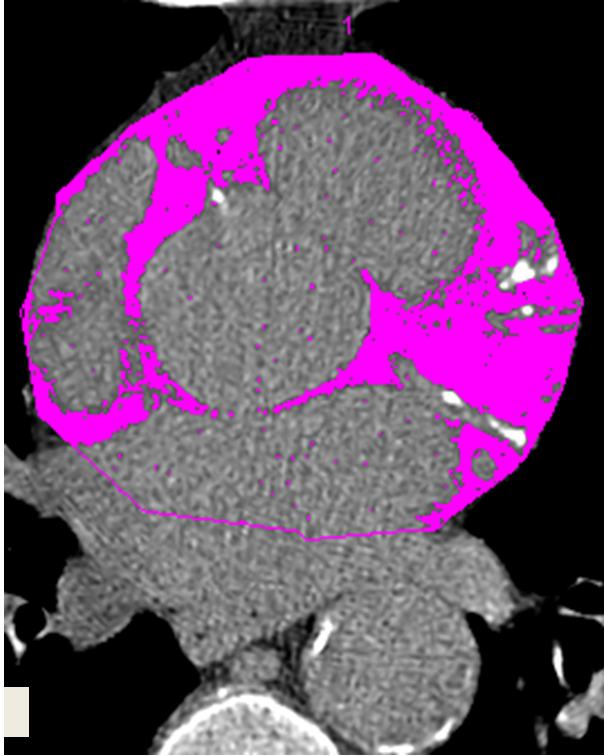
Pink portions of this CT scan indicate fat around the heart
International cardiac research led by a University of Alberta medical scientist shows fat deposits around the heart - that can be spotted via simple CT scans - are a solution to help predict death in chronic kidney disease patients. But the test isn't common clinical practice in Western Canada, says lead researcher Paolo Raggi.
"We wanted to know if this type of heart fat is related to poor outcomes for patients with chronic kidney disease, and it was a very clear marker of risk," says Raggi, a researcher with the Faculty of Medicine & Dentistry at the U of A and the academic director of the Mazankowski Alberta Heart Institute. "The greater the amount of fat around the heart, the greater the mortality rates were in patients."
Raggi collaborated with colleagues from Venezuela, Italy, and the United States on the findings, which were published in the peer-reviewed journal, Nephrology Dialysis Transplantation, earlier this summer. Raggi works in the faculty's Department of Medicine, and is also a world renowned cardiologist who was recruited to the U of A.
His team examined CT scan results from 109 U.S. patients with chronic kidney disease from a randomized, clinical trial and discovered that as the volume of fat around the heart increased, so did the risk of death. For every 10 cubic centimetre increase in heart fat, the risk of death rose six per cent, notes the article. Patients with higher than average amounts of heart fat had five-year survival rates of about 45 per cent - markedly lower than the 71 per cent survival rate for patients with lower than average amounts of heart fat.
The research also revealed other notable findings: that patients with chronic kidney disease had similar levels of heart fat to patients with coronary artery disease, and that the volume of heart fat rose with age and weight, and was more prevalent in Caucasians. The findings also demonstrated that high levels of calcium or plaque in the arteries and high cholesterol levels were strong predictors of large volumes of heart fat. Previous research has shown a link between this heart fat and plaque buildup in the heart arteries.
The article notes that chronic kidney disease patients do not usually receive CT heart scans. The authors recommend that clinical practice should include CT scans for these patients in the future with notes made on the test results about the amount of heart fat found.
"This is a new marker physicians can use for chronic kidney disease patients," says Raggi. "It's very easily implemented, and costs little. Currently, it's not used often enough in this part of Canada and physicians should have a more flexible approach to consider looking for this marker, which can be used to quickly estimate risk for their patients. Don't just look for calcium buildup in the arteries, look for fat volumes in the heart too."
Raggi cautioned physicians not to assume that thin patients have small volumes of heart fat. He has seen both extremes - thin patients with high volumes and overweight patients with small amounts of this dangerous heart fat.
Raggi introduced heart CT scanning into medical practice in the United States 18 years ago, and the test is now commonly used in the U.S. to predict risk of death for patients with chronic kidney disease.